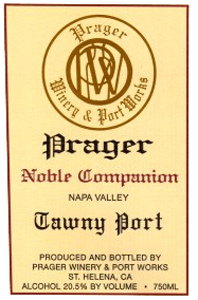

Prager Winery & Port Works
NV Noble Companion Tawny, Priest Ranch(Napa Valley)
The average age of the Cabernet Sauvignon from the Priest Ranch in the eastern hills of the Napa Valley near Chiles Valley, is 9 ¼ years. One wouldn’t think a tawny port could be fashioned from Cabernet, but here it is – all in a delicious package that one could cozy up to near a fireplace or in the boudoir.
Because what we have here is a brown-tinged wine that will warm the innards due to the alcohol (20 percent), and coat the tongue with hazelnut and sweet raisins.
The wine, aged in old oak barrels, primarily was harvested in 1994 and ’98 (36 percent from each vintage), with the balance from ’91, ’99, and ’00. The Priest Ranch is located in a niche known as Soda Valley. This historic ranch was settled by brothers, Joseph & Jacob Priest in the late 1860's and the land was farmed until it was purchased by Carl Rose in the early ‘60s. Rose was the first to plant grapes in this region, at the 1,200 foot elevation.
The residual sugar of the wine is 9.6 percent and there were only 312 cases produced.
Reviewed March 23, 2007 by Alan Goldfarb.
Other reviewed wines from Prager Winery & Port Works
|
Prager Winery & Port Works 2003 Royal Escort Vintage Port, Paladini Vineyard (Napa Valley)Alan Goldfarb 3/23/2007 |
The Wine
Winery: Prager Winery & Port Works |
The Reviewer Alan Goldfarb
Alan Goldfarb
Alan Goldfarb has been writing about and reviewing wine for 17 years. His reviews have been published in the St. Helena Star, San Jose Mercury, San Francisco Examiner, Decanter, and Wine Enthusiast, among others. Not once has he used a point system, star system, or an iconic symbol to quantify a wine. What counts in Mr. Goldfarb’s criteria when judging a wine is: how it tastes in the glass; is it well-constructed; its food compatibility; and presence of redeeming regional attributes. |












